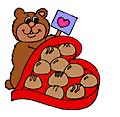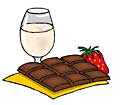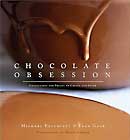|
|
 C’est Si Bon Bon: The Sweet History of Chocolate C’est Si Bon Bon: The Sweet History of Chocolate
by Marjorie Dorfman
What is it about the very word "chocolate" that makes mouths of all ages water? Where did it come from, how is it made and when did civilized society begin giving boxes of it away as tokens of love on special occasions? Read on for some sweet answers on a scrumptious subject, whether you prefer milk or dark, nuts or caramel-filled.
|
Although many may think of chocolate as a modern encounter of the sweetest kind, it is actually quite old, dating back to 250-290 AD and the Maya of Mesoamerica. During this Classical Period, chocolate was not eaten as a candy, but consumed as a bitter beverage, which played an important role in the religious and social lives of these ancient people. The first evidence of chocolate is found in the stone glyphs and remains of ancient vessels from this time period. The Mayan trade empire extended over southern Mexico, Belize, Guatamala, Honduras and part of El Salvador.
 Chocolate was a prized pleasure. Many artifacts depict scenes of people pouring and enjoying chocolate. The tasty secret of the cacao tree, which grew in the rainforest, remained so for many years. The Maya replanted the tree in their own backyards, where, under cover from other peeping ancient eyes, they harvested, fermented, roasted and ground the seeds into a paste. When mixed with water, chili peppers, cornmeal and other ingredients, this paste was transformed into a frothy, spicy chocolate drink. (If ingested properly, it might have even grown hairs on any formidable ancient chest.) Chocolate was a prized pleasure. Many artifacts depict scenes of people pouring and enjoying chocolate. The tasty secret of the cacao tree, which grew in the rainforest, remained so for many years. The Maya replanted the tree in their own backyards, where, under cover from other peeping ancient eyes, they harvested, fermented, roasted and ground the seeds into a paste. When mixed with water, chili peppers, cornmeal and other ingredients, this paste was transformed into a frothy, spicy chocolate drink. (If ingested properly, it might have even grown hairs on any formidable ancient chest.)
The Maya poured this mixture back and forth from the cup to the pot until it developed a thick foam on top. As sugar was yet unheard of in Meso-american culture, sweeteners probably came from a bit of honey or flower nectar. It was a treat for every citizen, no matter what their status in society, but the wealthy drank their chocolate from elaborate vessels decorated by artisans. These artifacts bear testimony to chocolate’s place in everyday Mayan life. Some depict kings, gods and even animals drinking chocolate. Mayan couples drank chocolate as part of their betrothal and wedding ceremonies.
As is the way of all flesh and civilization, the Maya were conquered by the Aztecs, who by the year 1400, dominated Meso-america, their territory extending from northern Mexico to the Mayan lands in Honduras. At first the Aztecs traded with the Maya for "cacao," but then they required their conquered citizens to pay their tributes in cacao seeds, which became a form of currency. (It is not known if the IRS of the day extracted similar amounts of cacao from the Aztecs to meet the demands of running a busy city-state.) Like the Maya, the Aztecs also consumed their bitter chocolate drink seasoned with spices, adding for use in their rituals, achiote (the seeds of the annatto tree), which turned the mixture blood-red.

For the Aztecs, the consumption of chocolate extended to priests, decorated soldiers and honored merchants. According to one legend, the god, Quetzalcoatl, brought heavenly cacao to the earth. The Aztecs could not cultivate the cacao tree in the dry highlands of Central Mexico, and so they traded with others to ensure a steady supply. Chocolate was so prized that Aztec traders filled their backpacks with cacao and hauled it on foot to the Aztec captial city, which is today Mexico City.
Although it is possible that other early explorers encountered cacao in the Americas, it wasn’t until 1521 that anyone in Europe learned of the delicious drink known as chocolate. It became a spoil of war when Cortes and The Conquistadores conquered the empire of Montezuma and the Aztecs and transported it to Spanish royal mouths. According to one legend, in 1544 Spanish priests on a visit to King Phillip of Spain, introduced chocolate to the king and the royal court. Whether this happened or no, chocolate was an immediate hit, and within a hundred years the love of chocolate spread throughout Europe.
The Spanish adored chocolate and keeping up with the demand for its consumption required the labor of millions to tend, harvest and process both sugar and cacao. From the early 1600s, enslaved Meso-americans on plantations provided this labor. One new tool was introduced to the chocolate trade: the molinillo, which was a stirring stick that made the job of whippping chocolate into a smooth foam much easier.
 Chocolate production was a Spanish monopoly for many years. (This did not include the get out of jail for free card and the passing of "go" without collecting two hundred dollars.) Like a jealous lover, the secret of how to make chocolate was heavily guarded, and only the wealthiest and most connected nobility could buy it. During the sixteenth century, The Spanish Catholic Church began drinking chocolate for energy, and it soon became known as a clerical fasting beverage. After much debate, the Church allowed people to drink chocolate as a nutritional substitute for food during fasting periods. Chocolate production was a Spanish monopoly for many years. (This did not include the get out of jail for free card and the passing of "go" without collecting two hundred dollars.) Like a jealous lover, the secret of how to make chocolate was heavily guarded, and only the wealthiest and most connected nobility could buy it. During the sixteenth century, The Spanish Catholic Church began drinking chocolate for energy, and it soon became known as a clerical fasting beverage. After much debate, the Church allowed people to drink chocolate as a nutritional substitute for food during fasting periods.
Who spread the word about chocolate to other European ears and mouths is not known. According to one legend, a group of English pirates who confiscated chocolate from a Spanish ship introduced the drink to England. Another tale says that Italian merchants purchased the secret of chocolate while on a business trip to Spain. Whichever may be the truth, it is a known fact that within a century’s passing all of the royal courts of Europe enjoyed chocolate. The trend lasted until the Industrial Revolution when production techniques made chocolate accessible to the public at large.
|
|
|
|
 |
|
|
 "Britain is the only country where the food is more dangerous than the sex." "Britain is the only country where the food is more dangerous than the sex."
Jackie Mason
"I come from a family where gravy is considered a beverage."
Erma Bombeck
|
Don't miss this excellent book:
Chocolate Obsession:
Confections and Treats to Create and Savor
by Michael Recchiuti, Fran Gage, Maren Caruso (Photographer)

Opening with a complete discussion of chocolate from bean to bar, this elegant array of recipes (more than 60), and ideas and flavors will bowl over every reader. The main author is Michael Recchiuti, a San Franciscan called the Picasso of Chocolatiers, and his cohort, Fran Gage, who once owned a locally esteemed patisserie and now writes for national gourmet-type publications. A must for all chocloate lovers.
|

Click for a printer friendly version of this article.
|
|